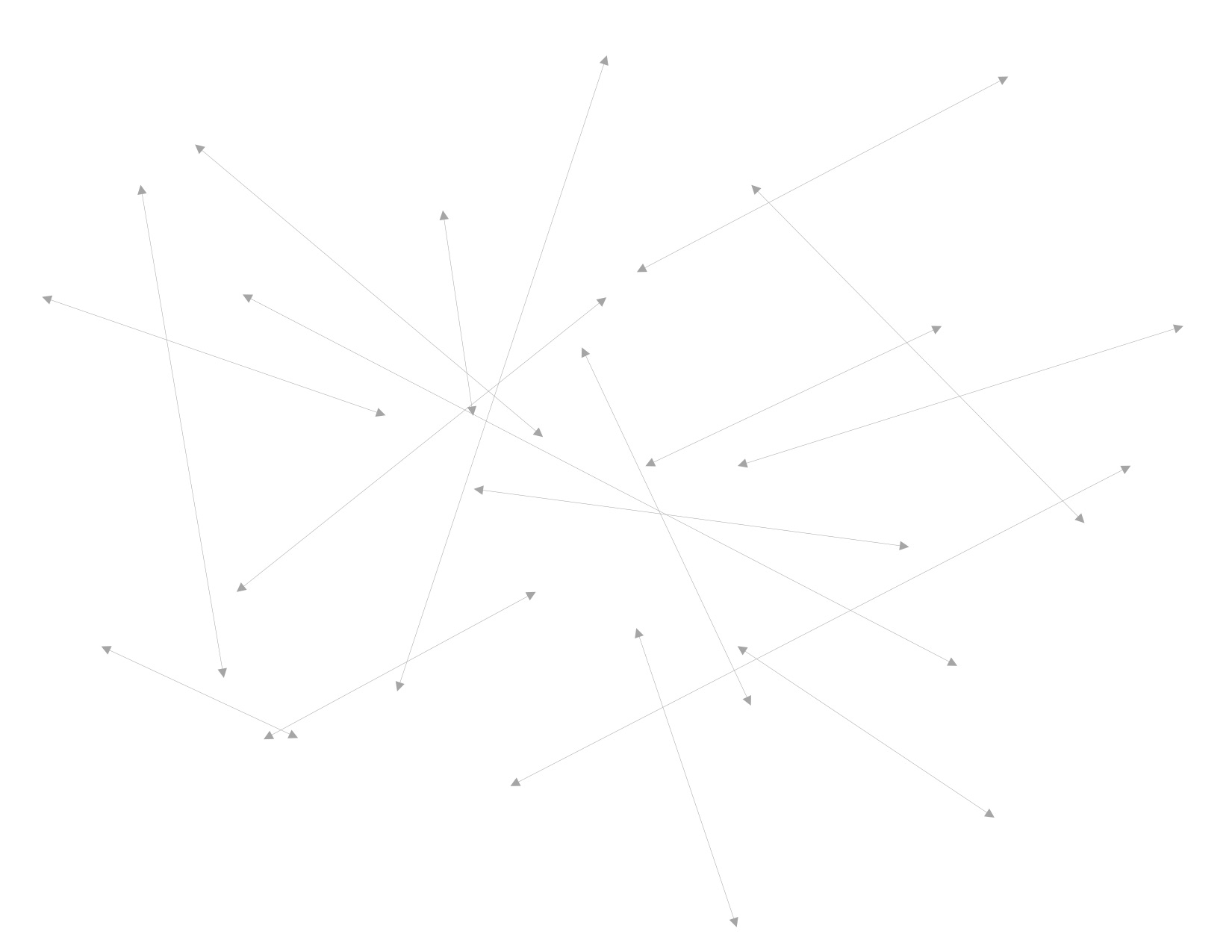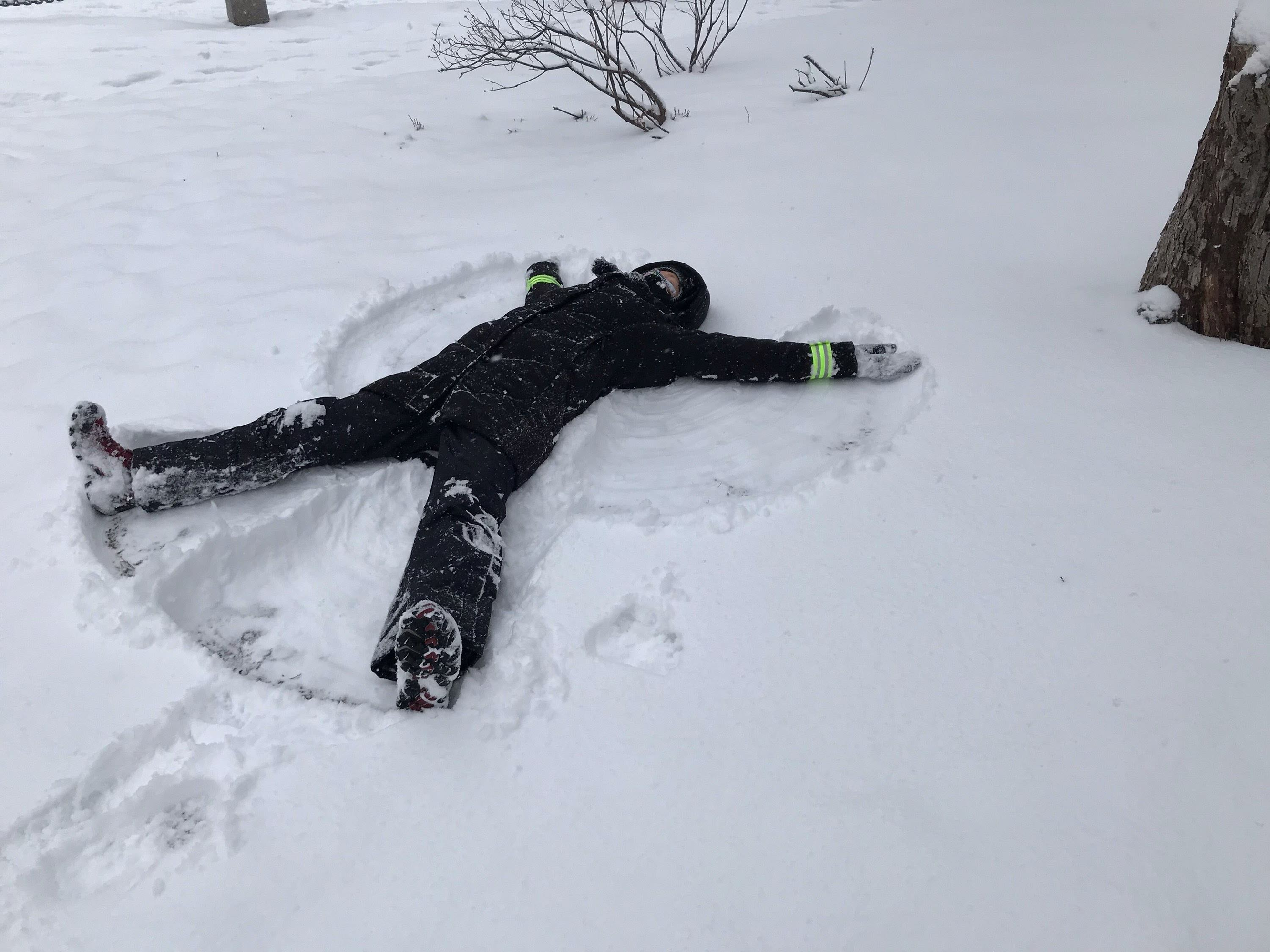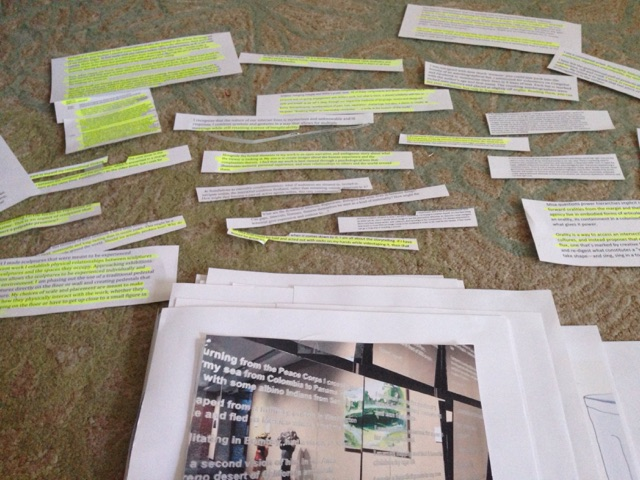My ongoing involvement in dance and somatic practices inform my approach to curating at every level, from initial conception to implementation. The activity of arranging—ideas, desires, artworks, and audiences—is a key aspect of how I define this work as choreographic. Arranging has spatial, aesthetic, and even civic characteristics: positioning works in the gallery, orchestrating sites of encounter for audiences, and extending the curatorial beyond the confines of the gallery, are a few strategies.
Juxtaposition is of particular interest. Interjecting an unexpected resource or material, or inviting one discipline to comment on or entangle with another is characteristic of my curatorial practice. I am especially delighted by intersections that at first glance produce non-coincidence or dissimilarity, what choreographer Litó Walkey characterizes as a type of commonplacing, or a “place where things usually not in proximity are brought together." (1)
The space itself and other people contribute a great deal to this process. The design of the Lamont Gallery and of the art center in which it is housed are sites of continuous exchange: the walls are punctuated by numerous glass doors and windows, making the space and our work accessible throughout the installation process.
This design promotes a multiplicity of seeing and moving. Each vantage point is not stationary, but rather echoes and extends your ability to look at, through, and beyond. During certain times of day, in different seasons, these glass thresholds become both reflective and porous, drawing the viewer into proximate and distant narratives. The trajectories of possible paths provide dramaturgical structure.
The windows and doors act as mirrors, amplifiers, and multipliers, producing temporary, immaterial, or imagined spaces as well as transitory subjectivities. The views can be confusing, and contradictory. What you see does not always make sense. The artworks and events are also sites of refraction and multiplication, whether or not their actual surfaces are reflective.
The gallery’s placement in an academic quad, on the corner of a well-traveled road (used by pedestrians, bicycles, and cars). Its location invites student gallery proctors, adult collaborators from campus, and public visitors in to participate as the process unfolds. People frequently come in to observe, help, comment, or give input (the research conversations for this project fostered this interchange in an intentional way). Everyone has a different opinion or perspective, each intertwined with my developing understanding of the project. Embracing this polyphony is a form of commonplacing.
Because the pandemic restricted access to the gallery. I could not spend much time with the work in the space. I could not benefit from the impromptu, ongoing participation from others, either. None of us collectively occupied the space over any significant duration.
Where is commonplacing without place, and the time that place permits?
Instead, I focused on developing a catalogue for Being & Feeling (Alone, Together). Through that process, I was reminded of additional links between my movement practice and my curatorial practice.
Developing the catalogue became an act of commonplacing, another way to encounter the project, differently than how it was installed in the gallery or showcased online. The catalogue made a space for reimagining curatorial alternatives.
(1) Litó Walkey, my notes from workshop, “Dramaturgy as Co-Imagining into Motion,” Zodiak Center for New Dance, Helsinki, Finland, 5-6 June 2019.
Curating is a mode of inquiry. Within the curatorial process, I rely on my body’s enmeshment in a context and place to help construct other bodies of knowledge. Without access to the gallery, it was difficult to reproduce or simulate the embedded subjectivity that working onsite affords me. Staring into my computer screen for hours was equally restrictive.
The lack of movement—within my own body and within the wider world—was preventing me from learning about the project in a fundamental way. I needed both space and time to generate the interplay between immersion and distance that is so critical to my understanding. In the first months of the pandemic spring, time seemed to collapse. I missed its differentiating rhythms. Being stuck in the present interrupted a critical part of my process.
I had to shift my perspective and my posture.
I became fixated on various floors and grounds—the slate floor of the gallery (during the infrequent times I was able to be there), the Marley of a dance studio, the uneven patchwork of brick and cement on the sidewalk. I needed these surfaces. The floor signals that I am connected to a place. The surface enables me to move.
To counter the hours of endless Zooming, and to find the ground I was missing, I began to work on the floor as much as possible.
These activities offer an alternate "thinking space." A conceptualizing motor and a method of inquiry. Workshops, ongoing sessions, and master classes with organizations including Zodiak Center for New Dance, the Trisha Brown Dance Company, and Movement Research have long accompanied my artistic research. Continued explorations of floorwork have been critical in informing and shaping my curatorial process.
Floorwork, when not an element of a choreographic sequence, is often considered part of a warm-up: it prepares you for more vigorous movement, attends to the body’s interconnected systems, and increases your range of motion.
By floorwork, I mean both work that takes place on, with, and in relation to the floor within a dance context, as well as spending time on the museum or gallery floor as a curatorial methodology. In this section, I focus more on the former, but the two types of floorwork are connected.
Floorwork is a way for me to notice sensations, explore areas of resistance, and pay attention to default movement and thinking.
There are countless versions and practices of floorwork, but many draw from the work of Rudoph Laban and Irmgard Bartenieff. If you have taken one modern or contemporary dance class within a Western context, you have likely engaged in some type of floorwork and its particular movement phrases.
Floorwork is grounded in physiology, with an awareness of muscle groups and how the muscles, bones, and tendons orchestrate movement. It is also associated with the developmental patterns of childhood, such as in the movements of flipping over, stretching, and crawling. Bartenieff developed exercises that combined her work with Laban with her training in kinesthetic therapies. Her exercises were designed to extend the range of motion and to contribute to functional mobility and health (Bartenieff worked with polio patients). To watch a floorwork sequence accompanied by a description of the fundamentals, see an example from the SomaKinese School here.
I have practiced versions of these fundamentals in so many dance classes that it is impossible to name them all. One of the more notable experiences was repeated seminars with Bill Evans, who draws extensively from Laban Barteieff Fundamentals as a pedagogical method.
Often the movement sequence starts on the floor. Gravity, rather than being something you fight against, is something you learn to lean on as a partner. You might begin in "the big X," and from there, engage in a sequence of movements that involve extending, curling, and moving homolaterally and cross-laterally, from your core to the distal ends of your fingers and toes. Common areas of focus include initiating, yielding, and pushing. Where does movement originate? How do you sustain it? What do you fight against and how do you let it go?
If you’ve ever made a snow angel, you’ve experienced part of the pleasure of moving in this manner.
On the floor, you don't worry about balance. Your vision becomes horizontal. You think less about how you look and more about the quality of your movement and how to extend your ability to notice. You attend to other sensations, such as temperature, light, or texture. You become aware of personal and physical conditions or limitations.
Throughout the pandemic, floorwork was recuperative. It also generated new insights.
Translating these ideas to the gallery setting:
Floorwork makes me pay attention to looking other, elsewhere, and alongside the work, instead of trying to consume or dominate it visually. It opens up an awareness of levels: how low are you? What is the impact of moving at midlevel or at a higher level? How can this awareness inform the placement of work in a gallery? What does a “low-level” movement—or display—do for or to the audience?
If you spend time in the gallery only looking at artworks along a line of sight that is in relation to your upright walking body and the gaze that accompanies it (think of why artworks are often hung at “eye-level,” which in the U.S. is often designated as 60 inches on center) you might miss something important. If you proceed by moving from piece to piece in a particular way—fully frontal, or at a certain distance—do you do this because it aids in your aesthetic awareness or insight? Or because it has become normalized in museum settings? What does it mean to be on the floor, low to the ground, or perceiving otherwise? What do these positions permit? What do they resist?
I use the sensory expansion provoked by movement floorwork to stretch my curatorial awareness. This often happens through movement (or stillness) in the gallery. During the exhibition layout, I consider what initiates movement. What happens when I shift the initiation from my own perspective (based on assumptions about what's expected or convenient) to paying attention to what the work itself initiates? Where does it want to go?
When I begin a project, I notice that I grip. When I ease up on the force and effort of trying to control or understand something—when I attend to my penchant for holding too tightly—I give the inquisitive part of curating much more dynamism.
Both the process of orchestrating curatorial themes before the artwork is on hand, and arranging works and audience in the gallery, are dependent on temporal access as well as physical: as in a somatic floorwork, taking time is critical. In the gallery, I am not in a rush to "throw the work up." I want to spend time with it, and by doing so, make time for ideas and connections to emerge.
Your pace is different in somatic floorwork—often it is slower. There is a meditative quality, which is sometimes challenging. You have to fight the urge just to get it done or get it over with or get on with it.
My curatorial process does not like to be rushed, either. Efficiency is not the aim. The time it takes for a curatorial project to unfold is an extended one: the experience is accumulative and not product-oriented, despite the very real demands for openings, events, and programs to take place at certain times.
Within the gallery space, I touch the works as much as, or sometimes more than, I look at them. Holding this sense does not just mean touching an artwork directly. It also means holding it in mind, or holding it (emotionally, spiritually, or even politically) in your presence. Perception needs to unfold: rarely do I get it immediately. It may be hours or years before something comes fully into my awareness.
In spring 2020, floorwork became especially useful.
Through developing a catalogue for Being & Feeling (Alone, Together) I explored how to come closer to the project. The catalogue was a space for advancing what could be as more proximate than what was.
In my living room, I spread out images and texts, juxtaposing them to spark connections not based on physical proximity in the gallery, but on mental, emotional, and atmospheric alliances.
I let my orientation to the reproductions of the works and the text be decidedly horizontal. Rather than standing, looking down, I sat, stretched out fully, or crawled around, a duet with the floor. Down low, I could look at the work from different angles. I could arrange it in various constellations. Proposing unusual pairings was a way to use commonplacing to discover unexpected aesthetic, formal, or narrative connections.
The catalogue conveyed the sensation of being in the gallery: the interior spread of reflections on the gallery floor, created by lights reflecting off Lauren Gillette’s piece, or a close encounter with the projection in Jon Sakata’s piece, which became the image for the endpapers.
This sea of papers became a space I could inhabit.
While I view my curatorial practice as site-responsive and context-specific, it is important to be able to envision a project apart from the site, at least at one point in the process. I am not proposing that the space is a blank canvas or some pure geometric abstraction. The works, and the context, are not neutral or ahistorical. A position, point of view, or context are themselves situations that are embedded in multiple, often contradictory narratives. Despite this awareness, it is still sometimes too easy to take a context as a given.
The catalogue process prevented me from relegating the work too quickly only to the existing gallery space or the way the work was installed. Floorwork allowed me to reimagine relationships. I knew that a specific painting was quite small, or that a sculpture had fine details that would not be evident under certain lighting or display situations. I was fully aware that a photograph that looked like it captured the cosmos was not as large as it seemed. Instead of assuming the given thtat was delineated by my body or by knowing the artworks’ sizes or associated narratives, I willfully misperceived. I let the small become vast and the vast become intimate.
If the (imagined) gallery was one space, the website was another. The Zoom events were spaces as well. The catalogue offered yet another space for a constellation of voices, ideas, and works. It invoked the imagined conversations of the face-to-face encounter and the shifts in thinking and perceiving these encounters produce. (I would have liked to develop a catalogue that allowed the reader to make their own experiential connections. However, I did not want to do this electronically. The lack of public access to the gallery and our reliance on screens compelled me to pursue a printed text that could convey physicality and take up space in future gallery archives.)
A desire for relationship was the motivation. The catalogue attempted to honor that desire, in all the ways it moved and shifted through physical, virtual, solitary, and shared spaces over the course of the project.





